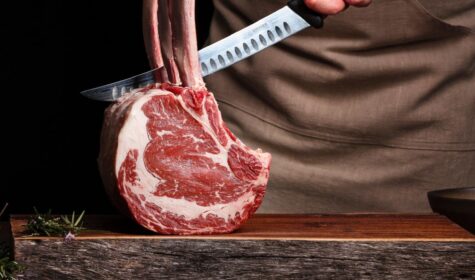Marianne Landzettel has been looking at sustainable agricultural systems and relocalised food production in her native Germany. This is the third part of a detailed examination of a small abattoir and how it works, how they offer improved animal welfare and how the meat that it produces feeds a thriving local economy (see Part I and Part II here).
In the evening, we’re meeting up with Rainer Waizenegger again, the organic dairy farmer in Legau who is one of the directors of the farmers’ association ‘Bauerngemeinschaft Illerwinkel’. He will fill us in on its history and the legal set up of the association.
Traditionally, farmers sold their animals to a local butcher who then processed the meat. Villages often had more than one butcher and farmers had a choice of whom to sell to; relationships were based on quality and trust. Things changed when supermarkets and retailers moved to greenfield sites and customers were able to buy everything that they needed in one place. As in the UK, many villages lost their shops and their butchers and bakers because they just weren’t profitable anymore.
In the late 1990s, farmers in Legau wondered how they might reverse that trend in their area. The Allgäu is a dairy region, and in any given year, dairy farmers usually have only a few calves, the occasional heifer or an elderly dairy cow to sell for slaughter. Large abattoirs process hundreds or even thousands of animals a day and they can’t or won’t deal with farmers delivering just one or two animals.
Waizenegger was among the farmers who thought setting up their own slaughter facility and marketing the meat locally was the best way forward. In 1997, 65 farmers from and around Legau founded the association, with a subsidiary for the butchery and the shop.
Things worked really well until disaster struck in 2016: the 40-year-old master butcher who had set up the butchery and built the brand – meats and sausages from ‘Bauerngemeinschaft Illerwinkel’ have an excellent reputation far beyond Legau – was diagnosed with late stage cancer in April. In June, the father of three was dead. Even retelling the story five years later, Waizenegger is still visibly upset, everyone in the community was shocked and deeply saddened. To keep the business running, the farmers’ association had to recruit a new master butcher – and fast. The first one left after only six weeks, the second stayed for a year – that’s how long it took to finally get him to leave. ‘He nearly ruined us,’ says Waizenegger, ‘suddenly, the quality of the products was awful, customers complained and stayed away. One of the sales assistants told us the butcher used only three different spices for all of the 60 types of sausage he was supposed to make. It was a complete nightmare. In the end we cut his wages, that finally made him leave.’
Throughout that year, Thomas Kling continued to work alongside the butcher and tried to prevent things from going even more awry. The members of the farmers’ association begged him to sit his exam for master butcher and take over the running of the abattoir and the butchery. But Kling couldn’t see himself in that role. Klaus Steinhaus had done his apprenticeship under the old master butcher and later had become his deputy. But after the butcher’s death, Steinhaus, left to work as a meat inspector. Only when it became clear that the Legau abattoir and butchery would have to close down if no one could be found to run it, he decided to return. He successfully passed his master butcher exam after just 10 weeks of studying and training. Today, the Illertissen farmers’ association is once again known for its outstanding quality.
Small-scale slaughter
How many animals per week are slaughtered, depends on customer demand. Because farmers bring individual animals for slaughter, the system has to be extremely flexible and finely balanced, says Waizenegger. Nobody wants animals backing up on farms because there is no capacity at the abattoir. I ask about the pigs we saw in the abattoir and the health issues, that the vet found. He is aware of the issue. ‘Everybody around here does dairy. It is really hard to source sustainably raised pigs but we keep trying.’ Pork is needed for most types of sausage in the shop.
Members of the farmers’ association very regularly deliver animals for slaughter. The price depends on the weight of the animal and weekly listings. Initially, there were rules which didn’t allow the use of antibiotics or GM feed, but there was no way to efficiently check compliance. But in the region, antibiotics are rarely used for dairy cattle anyway, says Waizenegger, and by now the dairy companies insist on the feed being GM free, and the dairies do have the means to enforce that rule.
Any farmer from the region can use the services of the abattoir, but the fees for members are about 10% less than those for non-members. Charges depend on the weight of the animal and what additional requirements the farmer has. It’s this customised service that farmers really value.
Only recently, the farmers’ association was able to buy the building in which the abattoir is situated. It belonged to a farmer who emigrated to Canada and sold the building without any land, at auction. The association’s first bid wasn’t high enough, but when the new owner lost the property in a night of high stakes poker, the farmers were able to buy it after all! Waizenegger doesn’t believe that an expansion is on the cards any time soon. They would have to invest in new equipment for vacuum packaging and hire more staff – which is almost impossible.
But the worst of the pandemic seems to be over, sales are picking up and Waizenegger believes that supply and demand are well balanced: there is enough demand for the animals that the farmers want to sell for slaughter. Meat and sausages from the butchery are not only sold at the shop in Legau but supplied to 10 other shops and local supermarkets with a meat counter. For now, farmers, butchers, sales’ staff and customers are pretty happy with how things are in Legau.
A good life and a good death
While we were in Legau, we also visited Herbert Siegel. He is an organic farmer in the village of Missen, a 40-minute drive from Legau and also in the Allgäu region. Siegel’s farm lies somewhat isolated on the side of a mountain. He took on the farm management in 1997 and immediately started conversion to organic. His animals are kept on grass year-round and calves are born outside and stay with their mums. Initially, the cattle were slaughtered at a nearby abattoir in Kempten. In 1998, Siegel took an 18-month-old animal to slaughter which had grown up in the herd. He knew it to be extremely docile and tame. When he arrived at the slaughter facility after a half hour drive, the animal was visibly distressed, shaking all over and covered in sweat. When Siegel tried to lead it out of the trailer, it attacked him – that he sustained no injuries was sheer luck, he says. He decided that he wanted to find a different way for his cattle to be slaughtered. If deer and wild boar could be shot in the field and their meat considered fine for human consumption, why was the same not possible for cattle? It took 18 years of talking to local authorities, animal welfare experts, veterinarians and other officials, as well as an EU rule change, until a protocol for shooting and killing animals on their pasture was finalised.
Siegel was one of the first to work with a ‘slaughter box’. Together with two other farmers, Siegel bought the ‘slaughter box’ at the cost of €10,000. It’s a large metal container which can be opened up like a box with hinges on the lid. It is empty except for a grid on which the animal can be placed for transport once killed. The first on site slaughter took place in August, 2016. Siegel has a herd of about 60 beef cattle and in 2020, he slaughtered 35 animals.
Slaughter on site, on a pasture and in proximity to the herd is the most animal friendly, humane way of slaughter, but it takes a lot of preparation and organisation. Only a trained hunter is allowed to shoot the animal from a distance of no more than 25 square metres. A vet has to be present for the shot – the inspection of the live animal could in theory happen on the day before. Once the hunter has shot the animal, there is a time frame of only 120 seconds which Siegel has to use a tractor to winch up the animal so that it hangs above the slaughter box. A butcher then cuts its throat and the animal dies by bleeding out into the slaughter box. The carcass is placed on the grid, the box is closed and the animal then has to be transported to a slaughter facility within two hours. Siegel is lucky, his brother is a butcher and a community owned abattoir is just seven kilometres away.
Valuing small local abattoirs
As in Legau, farmers in the village of Seltmans realised in the 1990s, that butchers and small abattoirs in need of investment were closing. Some 256 farmers from several villages came together and pledged to contribute financially to the building of a new facility, a statement of intent that meant the State of Bavaria would cover a large chunk of the overall costs. Today, the abattoir is used regularly by 30 to 40 farmers. The only employee is a caretaker who is responsible for the upkeep of the building and organising the schedule: farmers have to book the facility and bring their own butcher or team of butchers for slaughter and processing. The farmer members still pay a small annual fee, based on the number of cattle they keep. In this area, too, butchers are hard to find, but Siegel knows of several apprentices and within a 50-kilometre radius, there are still six or seven abattoirs, he says.
Once the sides of beef have been hung in cold storage for two weeks or the cuts have been matured in special ripening boxes, Siegel posts online that he has meat for sale. Customers place their orders and collect it at the abattoir on a given day. Prices are midrange for organic meat, says Siegel, he wants organic meat to be affordable for anyone, not just rich customers. ‘The real problem is that customers only want steaks and a few other cuts, I can only sell about half of the meat that could be used.’ For farmers who want their cattle to be slaughtered humanely, finding skilled butchers is one issue, the other one is marketing. Meat boxes may be a solution for some, but not all. Chefs have started to make use of animals’ ‘snout to tale’, and maybe consumers must learn to do the same.



